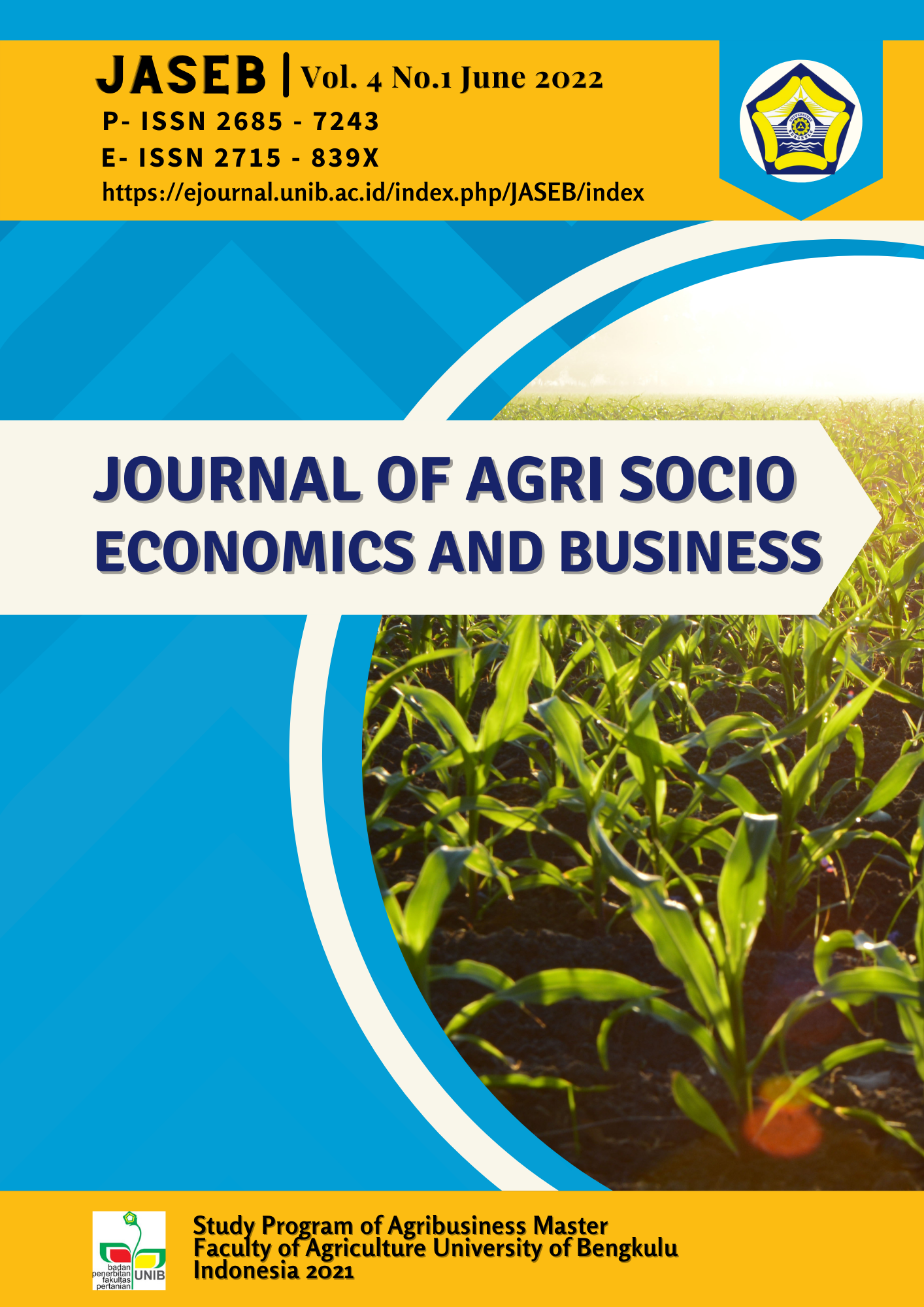Main Article Content
Abstract
Keywords
Article Details
An author who publishes in the Journal of Agri Socio Economics and Business agrees to the following terms:
Author retains the copyright and grants the journal the right of first publication of the work simultaneously licensed under the Creative Commons Attribution-ShareAlike 4.0 License that allows others to share the work with an acknowledgement of the work's authorship and initial publication in this journal
Submission of a manuscript implies that the submitted work has not been published before (except as part of a thesis or report, or abstract); that it is not under consideration for publication elsewhere; that its publication has been approved by all co-authors. If and when the manuscript is accepted for publication, the author(s) still hold the copyright and retain publishing rights without restrictions. For the new invention, authors are suggested to manage its patent before published. The license type is CC-BY-SA 4.0.
Journal Agri Socio-Economics and Business is licensed under a Creative Commons Attribution-ShareAlike 4.0 International License.
References
- Assis, K., Nurrul Azzah, Z & Mohammad Amizi. 2014. Relationship Between
- Socioeconomic Factors, Income And Productivity Of Farmers : A Case
- Study On Pineapple Farmers. International Journal of Research in
- Humanities, Arts and Literature.
- Badan Pusat Statistik Triwulanan 2016 – 2020. Statistik Produk Domestik Bruto.
- Indonesia Triwulanan [internet]. [diunduh 5 Desember 2020]. Tersedia pada
- https://.bps.go.id.
- Direktorat Jenderal Hortikultura. 2015. Rencana Strategis Direktorat Jenderal
- Hortikultura 2015 – 2019. Tersedia pada : http://hortikultura.pertanian.go.id/.
- [diunduh pada 9 Desember 2020]
- Direktorat Jenderal Hortikultura. 2015. Statistik Produksi Hortikultura Tahun
- Tersedia pada : http://hortikultura.pertanian.go.id/ [diunduh pada 10
- Desember 2020]
- Soekartawi. 2016. Analisis Usahatani. UI Press. Jakarta.
- Sugiyono. (2012). Teknik pengambilan sampel purposive adalah teknik penentuan
- sampel dengan pertimbangan tertentu. Dalam penelitian ini peneliti akan
- menetapkan beberapa kriteria sampel.
- Sugiyono. 2009. Metode Penelitian Pendidikan Pendekatan Kuantitatif, Kualitatif,
- dan R&D. Alfabeta; Bandung.
- Syafruddin, et al. 2003. Potensi dan kesesuaian lahan untuk pengembangan pakan
- ruminansia di lembah Palu. Prosiding Seminar Nasional Teknologi
- Peternakan dan Veteriner. Bogor,
- Thamrin, Muhammad., Ainul Mardhiyah dan Samsul Efendi Marpaung. 2013. Analisis Usahatani Ubi Kayu (Manihot utilissima). Jurnal Agrium, Vol. 18 (1): 57 – 63.
References
Assis, K., Nurrul Azzah, Z & Mohammad Amizi. 2014. Relationship Between
Socioeconomic Factors, Income And Productivity Of Farmers : A Case
Study On Pineapple Farmers. International Journal of Research in
Humanities, Arts and Literature.
Badan Pusat Statistik Triwulanan 2016 – 2020. Statistik Produk Domestik Bruto.
Indonesia Triwulanan [internet]. [diunduh 5 Desember 2020]. Tersedia pada
Direktorat Jenderal Hortikultura. 2015. Rencana Strategis Direktorat Jenderal
Hortikultura 2015 – 2019. Tersedia pada : http://hortikultura.pertanian.go.id/.
[diunduh pada 9 Desember 2020]
Direktorat Jenderal Hortikultura. 2015. Statistik Produksi Hortikultura Tahun
Tersedia pada : http://hortikultura.pertanian.go.id/ [diunduh pada 10
Desember 2020]
Soekartawi. 2016. Analisis Usahatani. UI Press. Jakarta.
Sugiyono. (2012). Teknik pengambilan sampel purposive adalah teknik penentuan
sampel dengan pertimbangan tertentu. Dalam penelitian ini peneliti akan
menetapkan beberapa kriteria sampel.
Sugiyono. 2009. Metode Penelitian Pendidikan Pendekatan Kuantitatif, Kualitatif,
dan R&D. Alfabeta; Bandung.
Syafruddin, et al. 2003. Potensi dan kesesuaian lahan untuk pengembangan pakan
ruminansia di lembah Palu. Prosiding Seminar Nasional Teknologi
Peternakan dan Veteriner. Bogor,
Thamrin, Muhammad., Ainul Mardhiyah dan Samsul Efendi Marpaung. 2013. Analisis Usahatani Ubi Kayu (Manihot utilissima). Jurnal Agrium, Vol. 18 (1): 57 – 63.
